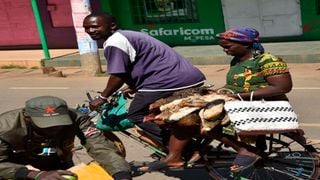
Bicycle boda boda in Kisumu.
| File | Nation Media GroupKisumu
Premium
Why some Kisumu residents still swear by bicycle boda bodas
Every morning, Joseph Otieno, 45, pays Sh30 to board a bicycle boda boda from his home in Kasagam to his place of work in Jua Kali in Kisumu.
It is quite a distance. He could take a shorter time to his destination if he used a motorcycle or tuk-tuk, but no, he prefers a bicycle.
On this day, his cyclist is Dismas Makheti, who is glad to take him to Jua Kali.
“I prefer using a bicycle anytime because it is safer. Although it is a bit slow, I’m sure of making it to my destination with minimal accidents,” Mr Otieno says.
He has seen fatal motorcycle accidents, he says, and does not want to be one of the statistics.
Intoxicated
“Some of these boys running around with motorcycles know nothing about the traffic regulations. They carry people around when they are intoxicated with alcohol,” he says.
We meet Mercy Onyango, negotiating with a bicycle boda boda operator to take her from Jubilee Market to the Kisumu city centre.
Mrs Onyango has remained loyal to bicycle taxis when she makes short distances in the lakeside city.
“I only part with as little as Sh20 to move about in town. Bicycles are cheap and safe to move about. There have been too many deadly motorcycle accidents lately,” she says.
Before motorcycles and tuk-tuks flooded the streets of Kisumu, bicycles were the common means of transport for short distances in the early 2000s.
Boda boda origin
Indeed, originally, the name boda boda referred to bicycle taxis.
There is no doubt motorcycles have come in handy in beating traffic jams in busy towns and manoeuvring in poor road networks, but they are the leading cause of deaths on Kenyan roads.
But Kisumu remains a holdout on the use of bicycles as taxis.
Data from the National Transport and Safety Authority showed that motorcycles retain an infamous record as the greatest rising cause of death.
Motorcycle deaths
Comparative statistics showed that in November 2018, some 511 motorcyclists were killed on various roads.
Perhaps it is these deaths that have made Mr Otieno and Mrs Onyango loyal bicycle users.
Dennis Onyango has been in the bicycle boda boda business for four years.
On a good day, he earns about Sh400 to ferry passengers in Kisumu.
He acknowledges that motorcycles are in high demand and faster compared with bicycles but says many residents remain faithful to bicycle rides.
“I have so many clients who prefer using a bicycle because of safety and affordability. Some appreciate our work and pay us as much as Sh100 for longer distances,” he says.
Support family
Through his boda boda business, Mr Onyango can support his family’s daily needs.
But he also views the job as a form of exercise that needs a balanced diet.
“Balancing is key in riding the bicycle. It also calls for one to eat a balanced meal to get the energy to ferry passengers around,” he says.
Recently, Kisumu Governor Anyang’ Nyong’o launched the ambitious Kisumu Sustainable Mobility plan with technical support from ITDP and UN-Habitat. The plan is to introduce a car-free day to encourage people to walk and cycle in the central business district.
In Kisumu, 53 per cent of daily trips are on foot, 4 per cent by bicycle, 13 per cent by matatu, 3 per cent by tuk-tuk, 13 per cent by boda boda, 6 per cent by motorcycle, and 6 per cent by car, the county government says.
Street space
Under the World Bank-financed Kenya Urban Support Programme, the city launched the Sh241 million Kisumu Triangle, involving the reconstruction of 1.5km of walkways on Oginga Odinga Street, Ang’awa Avenue, and Jomo Kenyatta Highway.
Governor Nyong’o reiterated that his administration was keen to ensure equitable allocation of street space.
“Considering that the majority of residents visiting the city centre are pedestrians and cyclists, we want them to experience improved accessibility and convenience as they go about their business,” he explained.





